Miami, Florida 作者: 来源: 发布时间:2021-07-20
I.Population and Area
₋Area
Land: 36.00 sq mi (93.23 km2)
₋Population
Total: 13,000.42/sq mi (5,019.42/km2)
Density: 399,457
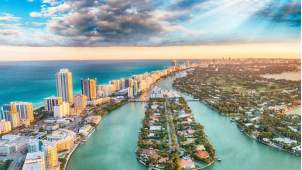
II.Natural Geography
₋Miami (/maɪˈæmi/), officially the City of Miami, is the seat of Miami-Dade County, and the cultural, economic and financial center of South Florida in the United States. The city covers an area of about 56 square miles (150 km2) between the Everglades to the west and Biscayne Bay to the east. Miami is the sixth most densely populated major city in the United States with an estimated 2019 population of 467,963. The Miami metropolitan area is home to 6.1 million people, the second-most populous in the southeastern United States and the seventh-largest in the nation. The city has the third tallest skyline in the U.S. with over 300 high-rises, 55 of which exceed 490 ft (149 m).
₋Miami is a major center and leader in finance, commerce, culture, arts, and international trade. The metro area is by far the largest urban economy in Florida and the 12th largest in the United States, with a GDP of $344.9 billion as of 2017. In 2018, Miami was classified as an Alpha level global city by the GaWC. In 2019, Miami ranked seventh in the United States and 31st among global cities in terms of business activity, human capital, information exchange, cultural experience, and political engagement. According to a 2018 UBS study of 77 world cities, the city was ranked as the third-richest in the United States and the eighth-richest in the world in terms of purchasing power. Miami is nicknamed the "Capital of Latin America" and is the largest city with a Cuban-American plurality.
₋Greater Downtown Miami has one of the largest concentrations of international banks in the United States, and is home to many large national and internati onal companies. The Health District is a major center for hospitals, clinics, and the biotechnology and medical research industries. PortMiami is the busiest cruise port in the world in both passenger traffic and cruise lines, and refers to itself as the "Cruise Capital of the World". Miami is also a major tourism hub for international visitors, ranking second in the country after New York City.
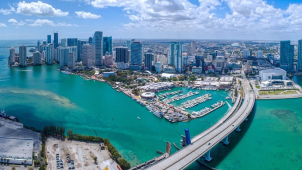
III.GDP
₋The average salary in Miami, FL is $62k. Trends in wages increased by 0.4 percent in Q1 2020. The cost of living in Miami, FL is 14 percent higher than the national average. The most popular occupations in Miami, FL are Operations Manager, Project Manager, (Unspecified Type / General), and Marketing Manager which pay between $37k and $123k per year. The most popular employers in Miami, FL are University of Miami (UM), Florida International University (FIU), and University of Miami School of Medicine.
₋Website: https://www.payscale.com/research/US/Location=Miami-FL/Salary
IV.Industrial Characteristics
₋Miami is a major center of commerce and finance and boasts a strong international business community. According to the 2018 ranking of world cities undertaken by the Globalization and World Cities Research Network (GaWC) based on the level of presence of global corporate service organizations, Miami is considered an Alpha level world city. Miami has a Gross Metropolitan Product of $257 billion, ranking 11th in the United States and 20th worldwide in GMP.
₋Several large companies are headquartered in Miami, including but not limited to Akerman LLP, Alienware, Arquitectonica, Brightstar Corporation, Celebrity Cruises, Carnival Corporation, Duany Plater-Zyberk, Element Solutions, Greenberg Traurig, Inktel Direct, Lennar Corporation, Norwegian Cruise Line, Oceania Cruises, OPKO Health, Parkjockey, RCTV International, Royal Caribbean International, Sitel, Southern Wine & Spirits, Telefónica USA, Telemundo, Vector Group, Watsco and World Fuel Services. Because of its proximity to Latin America, Miami serves as the headquarters of Latin American operations for more than 1400 multinational corporations, including AIG, American Airlines, Cisco Systems, Disney, ExxonMobil, FedEx, Kraft Foods, LEO Pharma Americas, Microsoft, Yahoo!, Oracle, Sony, Symantec, Visa, and Walmart. Additionally, companies based in nearby cities or unincorporated areas of Miami-Dade County include Bacardi, Benihana, Burger King, Carnival Cruise Line, Navarro Discount Pharmacies, Perry Ellis International, Ryder, Sedano's, UniMás, Univision, and U.S. Century Bank.
₋Miami is a major television production center, and the most important city in the United States for Spanish language media. Telemundo and UniMás have their headquarters in the Miami area. Univisión Studios and Telemundo Studios produce much of the original programming for their respective parent networks, such as telenovelas, news, sports, and talk shows. In 2011, 85% of Telemundo's original programming was filmed in Miami. Miami is also a significant music recording center, with the Sony Music Latin headquarters in the city, along with many other smaller record labels. The city also attracts many artists for music video and film shoots.
V.Attractions
1.Bayside Marketplace
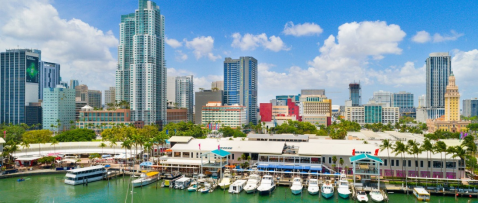
₋Bayside Marketplace is a two-story open air shopping center located in the downtown Miami, Florida. The banks of Biscayne Bay wrap around the property with the City of Miami marina at its side. It is recognized by the Greater Miami Convention & Visitor's Bureau as the number one most visited attraction in Miami. Different from typical shopping malls, Bayside offers an entertainment experience with live music daily, restaurants, bars, open-container policy, family events, and the picturesque settings that come with a waterfront property. Tenancy at the Bayside Marketplace consist of 140 inline spaces, in addition to over 50 carts and kiosks located in and around the center.
₋The entertainment complex opened during a major real estate boom in Miami. Instead of being planned to revitalize a specific area as its brother properties had, Bayside complements an existing marina. The shopping center was frequently featured on the crime drama TV series, Miami Vice.
₋Address: 401 Biscayne Blvd, Miami, FL 33132, United States
₋Website: https://www.baysidemarketplace.com/
2. Vizcaya Museum and Gardens
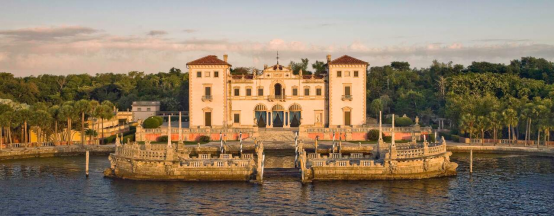
₋The Vizcaya Museum and Gardens, previously known as Villa Vizcaya, is the former villa and estate of businessman James Deering, of the Deering McCormick-International Harvester fortune, on Biscayne Bay in the present day Coconut Grove neighborhood of Miami, Florida. The early 20th century Vizcaya estate also includes: extensive Italian Renaissance gardens; native woodland landscape; and a historic village outbuildings compound. The landscape and architecture were influenced by Veneto and Tuscan Italian Renaissance models and designed in the Mediterranean Revival architecture style, with Baroque elements. F. Burrall Hoffman was the architect, Paul Chalfin was the design director, and Diego Suarez was the landscape architect.
₋Miami-Dade County now owns the Vizcaya property, as the Vizcaya Museum and Gardens, which is open to the public. The location is served by the Vizcaya Station of the Miami Metrorail.
₋The estate property originally consisted of 180 acres (73 ha) of shoreline Mangrove swamps and dense inland native tropical forests. Being a conservationist, Deering sited the development of the estate portion along the shore to conserve the forests. This portion was to include the villa, formal gardens, recreational amenities, expansive lagoon gardens with new islets, potager and grazing fields, and a village services compound. Deering began construction of Vizcaya in 1912 officially beginning occupancy on Christmas Day 1916 when he arrived aboard his yacht Nepenthe. The villa was built primarily between 1914 and 1922, at a cost of $15 million, while the construction of the extensive elaborate Italian Renaissance gardens and the village continued into 1923. During the World War I years building trades and supplies were difficult to acquire in Florida. Vizcaya is noteworthy for adapting historical European aesthetic traditions to South Florida's subtropical ecoregion. For example; it combined imported French and Italian garden layouts and elements implemented in Cuban limestone stonework with Floridian coral architectural trim and planted with sub-tropic compatible and native plants that thrived in the habitat and climate. Palms and Philodendrons had not been represented in the emulated gardens of Tuscany or Île-de-France.
₋Deering used Vizcaya as his winter residence from 1916 until his death in 1925. Paul Chalfin, a former art curator, painter, and interior designer, was the project's director. He assisted and encouraged Deering to collect art items, antiquities, and architectural elements for the project. Chalfin recommended the architect F. Burrall Hoffman to design the structural and envelope of the villa, garden pavilions, and estate outbuildings. The landscape master plan and individual gardens were designed with the Colombian landscape designer Diego Suarez, who had trained with Sir Harold Acton at the gardens of Villa La Pietra outside Florence, Italy. The estate's name refers to the northern Spanish province Vizcaya (In English Biscay), in the Basque region along the east Atlantic's Bay of Biscay, as 'Vizcaya' is on the west Atlantic's Biscayne Bay. Records indicate Deering wished the name also to commemorate an early Spaniard named Vizcaya who he thought explored the area, although later he was corrected that the explorer's name was Sebastián Vizcaíno. Deering used the Caravel, a type of ship style used during the 'Age of Exploration', as the symbol and emblem of Vizcaya. A representation of the mythical explorer "Bel Vizcaya" welcomes visitors at the entrance to the property.
₋Vizcaya's villa exterior and garden architecture is a composite of different Italian Renaissance villas and gardens, with French Renaissance parterre features, based on visits and research by Chalfin, Deering, and Hoffman. The villa facade's primary influence is the Villa Rezzonico designed by Baldassarre Longhena at Bassano del Grappa in the Veneto region of northern Italy. It is referred to sometimes as the "Hearst Castle of the East".
₋James Deering died in September 1925, on board the steamship SS City of Paris en route back to the United States. After his death Vizcaya was inherited by his two nieces, Marion Deering McCormick, wife of Chauncey McCormick, and Barbara Deering Danielson, wife of Richard Ely Danielson. Over the decades, after hurricanes and increasing maintenance costs, they began selling the estate's surrounding land parcels and outer gardens. In 1945 they sold significant portions of the Vizcaya property to the Catholic Diocese of St. Augustine, Florida, to build Miami's Mercy Hospital. 50 acres (200,000 m2) comprising the main house, the formal gardens, and the village were retained. In 1952 Miami-Dade County acquired the villa and formal Italian gardens, needing significant restoration, for $1 million. Deering's heirs donated the villa's furnishings and antiquities to the County-Museum. Vizcaya began operation in 1953 as the Dade County Art Museum. The village and remaining property were acquired by the County during the mid-1950s. In 1994 the Vizcaya estate was designated as a National Historic Landmark. In 1998, in conjunction with Vizcaya's reaccreditation process by the American Alliance of Museums, the Vizcaya Museum and Gardens Trust was formed to be the museum's governing body.
₋Vizcaya Museum also features gilded era technology. There are old doorbells, a dumbwaiter and a dial-up telephone. Vizcaya’s telephone system was the first one in Miami-Dade County.
₋Address: 3251 S Miami Ave, Miami, FL 33129, United States
₋Website: https://vizcaya.org/
3. Miami Seaquarium
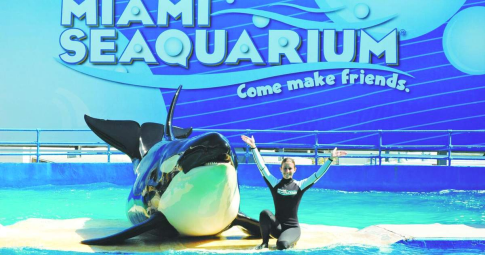
₋The Miami Seaquarium is a 38-acre (15 ha) oceanarium located on the island of Virginia Key in Biscayne Bay, Miami-Dade County, Florida, United States and is located near downtown Miami. Founded in 1955, it is one of the oldest oceanariums in the United States. In addition to marine mammals, the Miami Seaquarium houses fish, sharks, sea turtles, birds, reptiles, and manatees. The park offers daily presentations and hosts overnight camps, events for boy scouts, and group programs. Over 500,000 people visit the facility annually. The park has around 225 employees, and its lease payments and taxes make it the third-largest contributor to Miami-Dade County's revenue.
₋The park was founded by Fred D. Coppock and Captain W.B. Gray and was the second marine-life attraction in Florida. When it opened in 1955, it was the largest marine-life attraction in the world.
₋The park's first orca was Hugo, named after Hugo Vihlen. Hugo was captured in February, 1968 in Vaughn Bay. Shortly after his capture, Hugo was flown to the Miami Seaquarium where he was held in a small pool for two years. Over the course of 10 years, judging by his behavior, it was clear that Hugo didn't adjust to his life in captivity. Hugo would regularly bang his head against the walls of the tank. On March 4, 1980, Hugo died of a brain aneurysm.
₋From 1963 through 1967, eighty-eight episodes of the 1960s TV show Flipper and two movies starring Flipper were filmed at the Miami Seaquarium. From 1963 to 1991, the Seaquarium also had the Miami Seaquarium Spacerail, which was the first hanging monorail in the United States.
₋In 2014 Miami Seaquarium was bought by Palace Entertainment.
₋Address: 4400 Rickenbacker Causeway, Miami, FL 33149, United States
₋Website: https://www.miamiseaquarium.com/
VI.History
₋The Tequesta Native American tribe occupied the Miami area for around 2,000 years before contact with Europeans. A village of hundreds of people, dating to 500–600 B.C., was located at the mouth of the Miami River. It is believed that the entire tribe migrated to Cuba by the mid-1700s.
₋In 1566, admiral Pedro Menéndez de Avilés, Florida's first governor, claimed the area for Spain. A Spanish mission was constructed one year later. Spain and Britain successively ruled Florida until Spain ceded it to the United States in 1821. In 1836, the U.S. built Fort Dallas on the banks of the Miami River as part of its development of the Florida Territory and its attempt to suppress and remove the Seminoles. As a result, the Miami area became a site of fighting in the Second Seminole War.
₋Miami is noted as the only major city in the United States founded by a woman. Julia Tuttle, a local citrus grower and a wealthy Cleveland native, was the original owner of the land upon which the city was built. In the late 19th century, the area was known as "Biscayne Bay Country", and reports described it as a promising wilderness and "one of the finest building sites in Florida". The Great Freeze of 1894–95 hastened Miami's growth, as the crops there were the only ones in Florida that survived. Julia Tuttle subsequently convinced railroad tycoon Henry Flagler to extend his Florida East Coast Railway to the region, for which she became known as "the mother of Miami". Miami was officially incorporated as a city on July 28, 1896, with a population of just over 300. It was named for the Miami River, derived from Mayaimi, the historic name of Lake Okeechobee and the Native Americans that lived around it.
₋African American labor played a crucial role in Miami's early development. During the early 20th century, migrants from the Bahamas and African-Americans constituted 40 percent of the city's population. Despite their role in the city's growth, their community was limited to a small space. When landlords began to rent homes to African-Americans around Avenue J (what would later become NW Fifth Avenue), a gang of white men with torches marched through the neighborhood and warned the residents to move or be bombed.
₋Miami prospered during the 1920s with an increase in population and infrastructure as northerners moved to the city. The legacy of Jim Crow was embedded in these developments. Miami's chief of police at the time, H. Leslie Quigg, did not hide the fact that he, like many other white Miami police officers, was a member of the Ku Klux Klan. Unsurprisingly, these officers enforced social codes far beyond the written law. Quigg, for example, "personally and publicly beat a colored bellboy to death for speaking directly to a white woman".
₋The collapse of the Florida land boom of the 1920s, the 1926 Miami Hurricane, and the Great Depression in the 1930s slowed development. When World War II began, Miami became a base for U.S. defense against German submarines due to its prime location on the southern coast of Florida. This brought an increase in Miami's population; 172,172 people lived in the city by 1940. The city's nickname, The Magic City, came from its rapid growth, which was noticed by winter visitors who remarked that the city grew so much from one year to the next that it was like magic.
₋After Fidel Castro rose to power in Cuba following the Revolution in 1959, many wealthy Cubans sought refuge in Miami, further increasing the city's population. Miami developed new businesses and cultural amenities as part of the New South in the 1980s and 1990s. At the same time, South Florida weathered social problems related to drug wars, immigration from Haiti and Latin America, and the widespread destruction of Hurricane Andrew. Racial and cultural tensions sometimes sparked, but the city developed in the latter half of the 20th century as a major international, financial, and cultural center. It is the second-largest U.S. city with a Spanish-speaking majority (after El Paso, Texas), and the largest city with a Cuban-American plurality.
VII.Other Information
₋According to the 2016 American Community Survey, 72.3% of working city of Miami residents commuted by driving alone, 8.7% carpooled, 9% used public transportation, and 3.7% walked. About 1.8% used all other forms of transportation, including taxicab, motorcycle, and bicycle. About 4.5% of working city of Miami residents worked at home. In 2015, 19.9% of city of Miami households were without a car, which decreased to 18.6% in 2016. The national average was 8.7 percent in 2016. Miami averaged 1.24 cars per household in 2016, compared to a national average of 1.8 per household.
₋Freeways and roads
₋Miami's road system is based along the numerical Miami grid where Flagler Street forms the east–west baseline and Miami Avenue forms the north–south meridian. The corner of Flagler Street and Miami Avenue is in the middle of Downtown in front of the Downtown Macy's (formerly the Burdine's headquarters). The Miami grid is primarily numerical so that, for example, all street addresses north of Flagler Street and west of Miami Avenue have "NW" in their address. Because its point of origin is in Downtown, which is close to the coast, the "NW" and "SW" quadrants are much larger than the "SE" and "NE" quadrants. Many roads, especially major ones, are also named (e.g., Tamiami Trail/SW 8th St), although, with exceptions, the number is in more common usage among locals.
₋With few exceptions, within this grid north–south roads are designated as Courts, Roads, Avenues or Places (often remembered by their acronym), while east–west roads are Streets, Terraces, Drives or occasionally Ways. Major roads in each direction are located at one mile intervals. There are 16 blocks to each mile on north–south avenues, and 10 blocks to each mile on east–west streets. Major north–south avenues generally end in "7" – e.g., 17th, 27th, 37th/Douglas Aves., 57th/Red Rd., 67th/Ludlam, 87th/Galloway, etc., all the way west beyond 177th/Krome Avenue. (One prominent exception is 42nd Avenue, LeJeune Road, located at the half-mile point instead.) Major east–west streets to the south of downtown are multiples of 16, though the beginning point of this system is at SW 8th St, one half mile south of Flagler ("zeroth") Street. Thus, major streets are at 8th St., 24th St./Coral Way, 40th St./Bird, 56th/Miller, 72nd/ Sunset, 88th/N. Kendall, 104th (originally S. Kendall), 120th/Montgomery, 136th/Howard, 152nd/Coral Reef, 168th/Richmond, 184th/Eureka, 200th/Quail Roost, 216th/Hainlin Mill, 232nd/Silver Palm, 248th/Coconut Palm, etc., well into the 300s. Within the grid, odd-numbered addresses are generally on the north or east side, and even-numbered addresses are on the south or west side.
₋All streets and avenues in Miami-Dade County follow the Miami grid, with a few exceptions, most notably in Coral Gables, Hialeah, Coconut Grove and Miami Beach. One neighborhood, The Roads, is named as such because its streets run off the Miami grid at a 45-degree angle, and therefore are all named roads.
₋Miami-Dade County is served by four Interstate Highways (I-75, I-95, I-195, I-395) and several U.S. Highways including U.S. Route 1, U.S. Route 27, U.S. Route 41, and U.S. Route 441.
VIII.Contact Information
₋Government
Type: Mayor–commission
Mayor: Francis X. Suarez (R)
₋City Hall
₋TEL: Dial 311 or 305-468-5900
₋Address:
444 SW 2nd Ave
Miami, FL, 33130
₋Website: https://www.miamigov.com/Home
